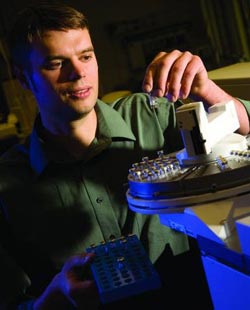New data show agricultural anabolic steroids regenerate in aquatic ecosystems

Ed Kolodziej is an associate professor and researcher in the University of Nevada, Reno's College of Science and project leader of a collaborative multi-disciplinary research team that includes the University of Iowa and Truman State. He and his team found a new mechanism where chemicals transform, under certain conditions, to avoid detection, which may account for unexplained observations of endocrine disruption in aquatic organisms.<br><br>Credit: Photo courtesy of University of Nevada, Reno.<br>
New regulatory approaches may be needed to assess environmental risks of agricultural growth promoters, and similar human pharmaceuticals, following research that shows a newly found reversion mechanism allows unexpected persistence of the steroidal substances in aquatic environments.
Results of the research will be published in an article in the renowned journal Science – the weekly journal of AAAS, the science society – next month and are available immediately online in Science Express.
“We investigated trenbolone, an anabolic steroid, and found that the photochemical breakdown isn't the end of its life cycle,” Ed Kolodziej, co-author of the paper and environmental engineering professor at the University of Nevada, Reno, said. “Our team found that these substances, after a rapid breakdown in sunlight, are capable of a unique transformation in aquatic environments under various temperature and light-cycle scenarios where the process is reversed.”
Kolodziej, project leader of a collaborative multi-disciplinary research team that includes the University of Iowa and Truman State, said this newly found mechanism may account for unexplained observations of endocrine disruption in aquatic organisms.
“Right now, I'm not alarmed, just concerned and interested in defining the real ecological risks associated with the widespread use of potent steroidal pharmaceuticals,” Kolodziej, who has been studying the effects of these substances on aquatic ecosystems for 12 years, said. “This implies uncertainty with the current environmental risk assessments or ecotoxicology studies used by regulatory agencies, researchers and pharmaceutical companies.”
The team used laboratory and field studies to explore the process. They found that the steroid's chemical compounds, while breaking down as expected in sunlight, never fully disappeared; even in conditions that mimicked surface water, a small percentage of the chemical structure remained after extended sunlight. The remains regenerated themselves at night, in some cases to up to 70 percent of the metabolites initial mass.”
“We knew something unique was going on,” David Cwiertny, Kolodziej's research partner from the University of Iowa, said. “In daylight, it essentially hides in another form, to evade analysis and detection, and then at nighttime it readily transforms back to a state that we can detect.”
The researchers validated the lab results with two experiments in the field – one with water taken from the Iowa River in Iowa City, Iowa and the other from samples taken from a collection pond at a cattle rangeland and research operation in California's Central Valley run by the University of California, Davis.
Trenbolone is a federally approved drug widely used by the beef industry to promote weight gain and to increase feeding efficiency in cattle. The drug, although popular in the bodybuilding and weightlifting communities, and as an athletic performance enhancer, has long been banned for human use, and also is banned for agricultural uses in the E.U.
Trenbolone has been considered safe for ecosystems due to its initially rapid degradation, with studies pointing to an environmental half-life of less than a day. Studies have indicated that low concentrations of these endocrine disrupting environmental steroids affect fish, by reducing egg production of females and skewing the sex of some species.
The article can be found at the Science Express website: http://www.sciencemag.org/content/early/recent.
Kolodziej is an associate professor in the University of Nevada, Reno's College of Engineering. His website can found at http://www.unr.edu/cee/homepages/kolodziej/index.html.
Founded in 1874 as Nevada's land-grant university, the University of Nevada, Reno ranks in the top tier of best national universities. With nearly 19,000 students, the University is driven to contribute a culture of student success, world-improving research and outreach that enhances communities and business. Part of the Nevada System of Higher Education, the University has the system's largest research program and is home to the state's medical school. With outreach and education programs in all Nevada counties and home to one of the largest study-abroad consortiums, the University extends across the state and around the world. For more information, visit http://www.unr.edu.
Media Contact
More Information:
http://www.unr.eduAll latest news from the category: Ecology, The Environment and Conservation
This complex theme deals primarily with interactions between organisms and the environmental factors that impact them, but to a greater extent between individual inanimate environmental factors.
innovations-report offers informative reports and articles on topics such as climate protection, landscape conservation, ecological systems, wildlife and nature parks and ecosystem efficiency and balance.
Newest articles

High-energy-density aqueous battery based on halogen multi-electron transfer
Traditional non-aqueous lithium-ion batteries have a high energy density, but their safety is compromised due to the flammable organic electrolytes they utilize. Aqueous batteries use water as the solvent for…

First-ever combined heart pump and pig kidney transplant
…gives new hope to patient with terminal illness. Surgeons at NYU Langone Health performed the first-ever combined mechanical heart pump and gene-edited pig kidney transplant surgery in a 54-year-old woman…

Biophysics: Testing how well biomarkers work
LMU researchers have developed a method to determine how reliably target proteins can be labeled using super-resolution fluorescence microscopy. Modern microscopy techniques make it possible to examine the inner workings…





















